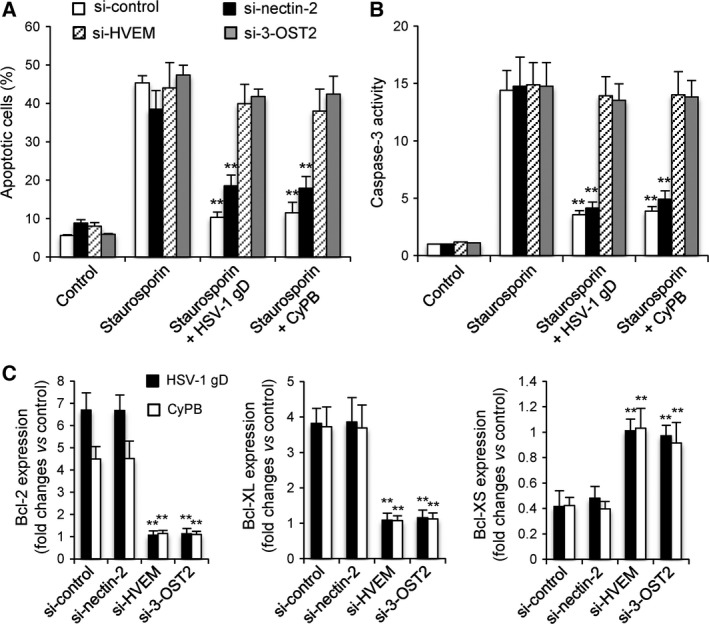Figure 7.

Effects of silencing the expression of 3‐OST2, HVEM and nectin‐2 on the anti‐apoptotic properties of HSV‐1 gD and CyPB. The contribution of 3‐OST2 (as a 3‐O‐sulfated HS‐generating enzyme) and of HVEM and nectin‐2 to the protective effect of HSV‐1 gD and CyPB was analysed by measuring staurosporin‐induced apoptosis in siRNA‐treated macrophages. Following treatment with siRNA for 48 h, cells were incubated or not with HSV‐1 gD and CyPB (1 μg·mL−1) for 8 h, after which they were exposed to staurosporin (0.5 μm) for 4 h. (A) The percentage of apoptotic cell population was evaluated by analysing the binding of fluorescein‐conjugated annexin‐V. Each bar of histogram represents mean ± SD of the rate of apoptotic cells (annexin‐V+/PI−) obtained from five distinct experiments. (B) In parallel experiments, the activation of caspase‐3 was analysed in siRNA‐treated cells after exposure to staurosporin. Results are expressed as fold increase in caspase‐3 activity by comparison with untreated cells and correspond to means ± SD from five independent experiments (**P < 0.01, significantly different when compared with the results obtained with staurosporin alone). (C) Variations in the expression of Bcl‐2, Bcl‐XL and Bcl‐XS was analysed in siRNA‐treated macrophages following incubation with HSV‐1 gD or CyPB (1 μg·mL−1) for 8 h. After extraction of total RNA and reverse transcription, the expression of mRNA encoding Bcl‐2, Bcl‐XL and Bcl‐XS was analysed by real‐time RT‐PCR. Relative transcript abundance was normalized to HPRT mRNA. Results are expressed as fold changes by comparison with nonstimulated cells and correspond to means ± SD of three separate experiments (**P < 0.01, significantly different when compared to the results obtained with negative control siRNA).
